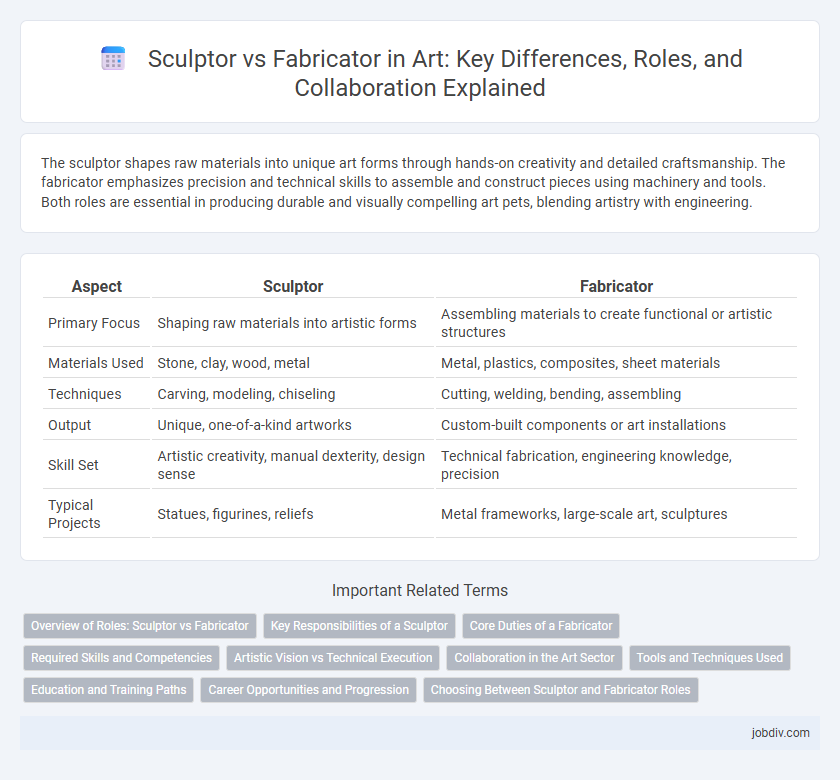The sculptor shapes raw materials into unique art forms through hands-on creativity and detailed craftsmanship. The fabricator emphasizes precision and technical skills to assemble and construct pieces using machinery and tools. Both roles are essential in producing durable and visually compelling art pets, blending artistry with engineering.
Table of Comparison
| Aspect | Sculptor | Fabricator |
|---|---|---|
| Primary Focus | Shaping raw materials into artistic forms | Assembling materials to create functional or artistic structures |
| Materials Used | Stone, clay, wood, metal | Metal, plastics, composites, sheet materials |
| Techniques | Carving, modeling, chiseling | Cutting, welding, bending, assembling |
| Output | Unique, one-of-a-kind artworks | Custom-built components or art installations |
| Skill Set | Artistic creativity, manual dexterity, design sense | Technical fabrication, engineering knowledge, precision |
| Typical Projects | Statues, figurines, reliefs | Metal frameworks, large-scale art, sculptures |
Overview of Roles: Sculptor vs Fabricator
Sculptors conceive and create original artworks by shaping materials such as stone, metal, or clay, relying on artistic vision and manual skill to produce expressive forms. Fabricators specialize in executing designs, often collaborating with artists to transform concepts into large-scale or complex structures using industrial techniques like welding, machining, and assembly. The sculptor drives creative direction and aesthetics, while the fabricator ensures structural integrity and precision in the realization of the art piece.
Key Responsibilities of a Sculptor
A sculptor is primarily responsible for conceptualizing and creating three-dimensional artworks by carving, modeling, or assembling materials such as clay, stone, metal, or wood. Their key duties include designing original pieces, mastering various sculpting techniques, and ensuring the artistic vision is accurately realized through meticulous craftsmanship. Sculptors also research historical styles and contemporary trends to innovate and refine their creative output within the art world.
Core Duties of a Fabricator
Fabricators in art specialize in transforming artistic designs into tangible structures, often working with metal, wood, and other materials to execute complex sculptures. Their core duties include interpreting sculptors' plans, welding, cutting, assembling components, and ensuring structural integrity and durability. Precision craftsmanship and technical knowledge of materials and machinery are essential for fabricators to realize the sculptors' creative visions accurately.
Required Skills and Competencies
Sculptors require strong artistic vision, mastery of traditional sculpting techniques, and a deep understanding of materials like clay, stone, and metal to create original artworks. Fabricators need advanced technical skills in welding, machining, and assembly, often utilizing CAD software to construct large-scale sculptures or installations from varied materials. Both roles demand precision, spatial awareness, and problem-solving abilities, but sculptors focus on creative design while fabricators emphasize structural execution and material manipulation.
Artistic Vision vs Technical Execution
The sculptor shapes the artistic vision, infusing creativity and emotional depth into the piece, while the fabricator translates this conceptual design into physical reality through precise technical execution. Mastery of materials and engineering expertise are crucial for the fabricator to realize complex sculptures that maintain structural integrity. Collaboration between sculptor and fabricator ensures that innovative ideas are successfully transformed into durable, visually compelling artworks.
Collaboration in the Art Sector
Sculptors and fabricators often collaborate closely in the art sector to transform artistic visions into tangible works, combining creative design with technical expertise. Fabricators provide critical knowledge in materials, engineering, and construction, enabling sculptors to achieve complex structural forms and large-scale installations. This partnership enhances the feasibility of ambitious projects, ensuring artistic integrity while meeting practical constraints such as durability and installation requirements.
Tools and Techniques Used
Sculptors primarily use traditional tools such as chisels, hammers, and rasps to carve or model materials like stone, wood, and clay, emphasizing handcrafting techniques that require precision and artistic skill. Fabricators rely on advanced machinery and technology, including welding equipment, plasma cutters, and computer-aided design (CAD) software to assemble and manipulate metals, plastics, and composites for large-scale or industrial art projects. The integration of digital tools in fabrication allows for complex, precise constructions that differ from the manual, tactile process central to sculpting.
Education and Training Paths
Sculptors often pursue formal education in fine arts, attending art schools or universities to study anatomy, materials, and traditional sculpting techniques. Fabricators typically follow specialized training in industrial design, metalworking, or engineering, gaining hands-on experience with tools and machinery through technical schools or apprenticeships. Both education paths emphasize the development of spatial skills and material knowledge, but sculptors prioritize artistic expression while fabricators focus on technical precision and structural integrity.
Career Opportunities and Progression
Sculptors often have opportunities to develop a unique artistic style and exhibit their work in galleries, progressing through commissions and residencies that build their reputation. Fabricators typically find career growth in collaborating with artists, architects, or industrial designers, specializing in material manipulation and technical execution for large-scale projects. Both paths offer advancement through networking in creative industries, with sculptors emphasizing personal expression and fabricators focusing on craftsmanship and project management.
Choosing Between Sculptor and Fabricator Roles
Choosing between a sculptor and a fabricator depends on the project's artistic vision and technical requirements. Sculptors bring creative design and hands-on craftsmanship, focusing on form, aesthetics, and conceptual expression in materials like clay, stone, or metal. Fabricators specialize in precision, engineering, and assembly, often working with industrial tools and techniques to realize complex structures or large-scale installations.
Sculptor vs Fabricator Infographic

 jobdiv.com
jobdiv.com